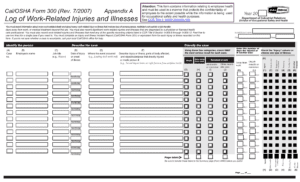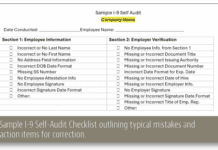
California’s Senate Bill 553 (SB 553) addresses the pressing issue of workplace violence by mandating businesses to adopt Workplace Violence Prevention Plans (WVPP). Effective July 1, 2024, SB 553 amends California Labor Code 6401.7 and adds 6401.9, making it the first law to recognize workplace violence as an occupational hazard regulated by Cal/OSHA.
WWCNKey components of SB 553 include:
• Workplace Violence Definition: Threats or use of physical force against an employee that could result in injury, psychological trauma or stress.
• WVPP Requirements: A written, accessible plan including 13 statutory requirements.
• Incident Log: Written records of qualifying incidents maintained for five years.
• Training: Effective training is provided initially and annually, covering at least six statutory requirements.
• Records Retention: Various WVPP, training and incident response records must be maintained for specific periods and made available upon request.
Non-compliance can lead to fines, enhanced civil liability, and reputational damage. Implementing a comprehensive WVPP is not only a requirement but a demonstration of your vigilance to the safety of those in your operations. Such a plan should be clear and accessible, meeting all statutory requirements while being tailored to the workforce’s specific needs.
Initial Assessment and Evaluation of Risk Factors
Any preventive measure and procedure taken by an employer to correct, respond to or prevent workplace violence must be determined based on a thorough understanding of the risk factors and/or hazards associated with the various types of workplace violence that exist in the workplace.
Every employer must perform an initial assessment to identify and evaluate workplace violence hazards which have been shown to, or that may contribute to the risk of violence in the workplace. Potential factors that could exist in workplaces that may increase the risk of workplace violence include but are not limited to:
• Exchange of money.
• Working alone.
• Working at night and during early morning hours.
• Availability of valued items (e.g., money and jewelry).
• Guarding money or valuable property or possessions.
• Performing public safety or social welfare functions in the community.
• Working with clients, passengers, customers or students known or suspected to have a history of violence.
• Employees with a history of assaults or who have exhibited belligerent, intimidating or threatening behavior to others.
Workplace Violence Prevention Plan Requirements
Employers are required to address workplace violence hazards to protect employees and comply with the regulatory requirement of establishing, implementing and maintaining an effective written WVPP. Per LC 6401.9, employers must include the following required elements and effective procedures in their establishment’s written WVPP or include them as a separate section in their IIPP for Workplace Violence Prevention:
• Names/titles of persons responsible for implementing the written WVPP.
• Procedures to obtain the active involvement of employees and authorized employee representatives in developing and implementing the WVPP.
• Methods the employer will use to coordinate the implementation of the plan with other employers.
• Procedures to ensure all employees (supervisory and nonsupervisory) comply with the WVPP.
• Procedures to communicate and provide training to employees on workplace violence.
• Procedures to identify, evaluate and correct workplace violence hazards.
• Procedures on how to respond to actual or potential workplace violence, and how to accept and respond to reports of workplace violence, including procedures to prohibit retaliation against employees for reporting workplace violence.
• Procedures for post-incident response and investigation.
• Procedures to review WVPP for effectiveness and revise the plan as needed.
• Procedures or other information required by the division and standards board as being necessary and appropriate to protect the health and safety of employees.
Employers can prevent and reduce the risk of workplace violence with an established, effectively implemented, and maintained WVPP, along with strong management commitment and the day-to-day involvement of all employees and their authorized representatives.
Framework for Combating Workplace Violence in the Ag Industry
As you begin to develop your plan, take into consideration a framework to implement and orient your staff. The following are suggestions for successful implementation:
1. Policy Development and Communication
• Develop Clear Policies: Establish comprehensive policies that define workplace violence, including physical violence, verbal abuse, bullying and harassment. Ensure policies comply with federal, state and local regulations.
• Communicate Policies: Regularly communicate these policies to all employees through training sessions, employee handbooks and visible postings in the workplace.
2. Training and Education
• Regular Training Programs: Conduct mandatory training for all employees on recognizing, preventing, and responding to workplace violence. Training should cover de-escalation techniques, reporting procedures and the impact of workplace violence.
• Specialized Training for Supervisors: Provide additional training for supervisors and managers on handling complaints, conducting investigations and supporting affected employees.
3. Reporting and Response Procedures
• Establish Reporting Mechanisms: Create multiple channels for reporting incidents of workplace violence, such as hotlines, online forms and direct reporting to supervisors.
• Confidentiality Assurance: Ensure that reporting mechanisms guarantee confidentiality and protect employees from retaliation.
• Immediate Response Plans: Develop and implement response plans for handling reported incidents. These should include steps for securing the safety of all employees, providing immediate support to victims and initiating investigations.
4. Support Systems for Affected Employees
• Employee Assistance Programs (EAP): Offer access to counseling and support services for employees affected by workplace violence.
• Peer Support Networks: Establish peer support groups where employees can share experiences and receive support in a safe and confidential environment.
5. Workplace Environment and Safety Measures
• Risk Assessments: Conduct regular assessments to identify potential risks for workplace violence and implement measures to mitigate these risks.
• Enhanced Security: Implement security measures such as surveillance cameras, alarm systems, controlled facility access and adequate lighting.
• Safe Work Practices: Promote a culture of safety by encouraging employees to report unsafe conditions and participate in safety committees.
6. Monitoring and Continuous Improvement
• Incident Tracking: Maintain a detailed log of all reported incidents of workplace violence to identify patterns and areas requiring attention.
• Regular Reviews: Periodically review policies, training programs and incident response procedures to ensure they remain effective and up to date.
• Feedback Mechanism: Establish a feedback system where employees can provide input on the effectiveness of workplace violence prevention measures.
7. Compliance with Regulations
• Stay Informed: Regularly update policies and practices to comply with the latest federal, state and local regulations regarding workplace violence.
• Documentation: Keep thorough records of all training sessions, reported incidents, investigations and responses to demonstrate compliance with regulatory requirements.
• Engage Legal Counsel: Consult with legal experts to ensure all aspects of the workplace violence prevention program adhere to legal standards and best practices.
All California employers must identify and correct workplace hazards in a timely manner and provide effective training to their employees to prevent injuries from occurring as a result of their employment. Additionally, every employer must immediately report to Cal/OSHA any serious injury or illness, or death of an employee occurring in a place of employment or in connection with any employment, including incidents resulting from workplace violence.

What Should Employers Do If an Employee Is Injured Due to Workplace Violence?
• Ensure employees receive timely and appropriate medical treatment: Employers must ensure all needed medical care is provided through the employer’s workers’ compensation insurance provider.
• Provide Notice: Employers must give employees notice of workers’ compensation eligibility within one working day of a workplace violence incident.
• Record and Investigate: Record required information about the violent incident in the employer’s violent incident log, investigate and evaluate the workplace violence incident and determine and implement changes needed to reduce workplace violence hazards in the workplace.
• Review and Report: Review the effectiveness of the written WVPP and revise the plan if necessary. Report all serious injuries and deaths to Cal/OSHA and complete the “Employer’s Report of Occupational Injury or Illness” (Form 5020).
What Records Must Employers Keep on Workplace Violence?
• Records of workplace violence hazard identification, evaluation and correction for a minimum of five years.
• WVPP training records for a minimum of one year.
• Violence incident logs for a minimum of five years.
• Records of workplace violence incident investigations for a minimum of five years.
• Cal/OSHA Form 300 for five years.
By implementing this framework, agricultural work can effectively combat workplace violence, ensuring a safer environment for employees. The commitment to continuous improvement and compliance with regulations will not only protect employees, but also enhance the overall well-being, productivity and reputation of the organization. Creating a “speak-up” culture within the organization is another crucial aspect. Employees should feel safe to report concerns without fear of retaliation, further enhancing the organizational commitment to prioritizing psychological safety. This requires a commitment from leadership to support and protect those who come forward with issues or observations related to workplace safety.
If you should have specific questions about workplace violence prevention, please contact the AgSafe team at 209-526-4400 or email safeinfo@agsafe.org.
AgSafe is a 501c3 nonprofit that provides training, education, outreach and tools in safety, labor relations and human resources for the food and farming industries. Since 1991, AgSafe has educated over 100,000 employers, supervisors and workers about these critical issues.















